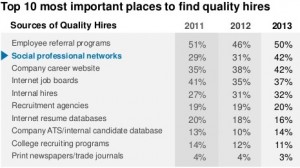 America’s recruiting leaders say their top priority this year is finding and hiring highly-skilled workers, and the places they’re turning to find them with increasing urgency are social networks.
America’s recruiting leaders say their top priority this year is finding and hiring highly-skilled workers, and the places they’re turning to find them with increasing urgency are social networks.
In the three years LinkedIn has surveyed talent acquisition leaders on their priorities and industry trends, the percentage of respondents who say professional social networks are the place to find “key quality hires” has gone from 29% to 42%. Social media now ties with the company career site as a candidate source, and both aren’t too far behind employee referral programs.
LinkedIn’s U.S edition of its 2013 Global Recruiting Trends survey shows American recruiting leaders to be not too different from leaders around the world. Both groups see the use of social media for sourcing talent as a long lasting trend; 36% for the U.S. compared to 39% globally.
Americans, though, put much more emphasis on finding methods of sourcing passive candidates than do leaders elsewhere. On LinkedIn’s list of 10 trends, 37% of U.S. respondents rate it first, versus 27% of other leaders.
One important revelation for search firms and staffing agencies is that 56% of the leaders expect an increase in the number of hires of full and part-time professionals.
Just under half that — 27% — expect an increase through the rest of this year in the number of contractors and temps they bring on board. Unlike the hiring of permanent staff, where only 10% expect a decrease, 30% expect to hire fewer temps.
Even so, the significant increase in permanent hires should mean a strong business climate for search firms; the survey says despite the hiring increases, only a third of the recruiting leaders expect their budgets to be increased.
Globally, the hiring picture is similar, but not as robust. More companies will decrease their perm hires (21%) and their contractor and temp hires (36%). Still, 44% will add perm staff.
One bigger difference between talent leader outside the U.S. and American recruiting leaders is over the approaches to employer branding. Americans don’t discount it, but see “Being a strategic talent adviser to the business” as a trend of longer lasting value. As a priority for American leaders, branding falls at the bottom of their list.
The irony is though that what they fear the most is that the competition will start investing in building their brand. According to LinkedIn, 85% believe the employer brand has “a significant impact on ability to hire great talent.” So they rated brand building by the competition first among the things the competition might do that would worry them the most.
Not surprisingly, recruiting leaders are coming to rely more and more on social and professional networks to promote their employer brand, and less — though still primarily — on the company website, and job boards. Rising 15% since just last year, online professional networks are considered the most effective way of promoting the brand by 54%.
Family and friends — word of mouth — still holds its luster, with 61% of the talent leaders rating it as most effective.
For all this importance assigned to branding, and the worries about the competition suddenly kicking up its promotion, only about a third of the respondents track it in any meaningful way. While analyzing online buzz can be costly, and “like” and “followers” are an imperfect metric, only 28% of U.S. recruiting leaders even bother to survey new hires about the brand significance. Oddly, more — 33% — say they measure their brand “relative to our competitors for talent.” What exactly that means and how they do it, isn’t part of the survey.
Detailed compilations for Europe, the Americas, and Asia Pacific